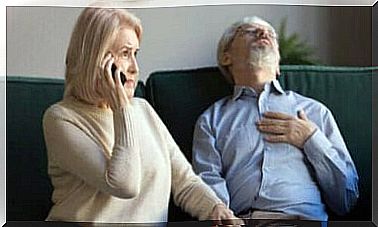Benign Paroxysmal Positional Vertigo

Benign paroxysmal positional vertigo is a problem that affects the inner part of the ear. It consists in the appearance of sudden episodes of short-lived dizziness.
Such dizziness is caused by changes in posture and is often accompanied by nystagmus. Generally speaking, paroxysmal positional vertigo occurs following the adoption of the posture that triggered it.
This condition is one of the most frequent causes of dizziness. It manifests itself with the perception that everything turns inside and outside one’s head. Benign paroxysmal positional vertigo is the leading cause of vertigo during first aid treatment.
It affects up to 25% of people who go to the doctor because of dizziness. It usually occurs in adults between the ages of 40 and 50, and up to 50% of cases are not attributable to a known cause.
While it can be an annoying problem, on very few occasions it is serious, except when it increases the chances of falling.
Symptoms of paroxysmal positional vertigo

Positional vertigo is characterized by brief episodes of dizziness. These dizziness can be mild to intense and often occur due to specific changes in the position of the head.
Nausea can occur when you tilt your head up or down, when you lie down or roll over in bed. You may feel that the room is spinning or that everything around is moving. This gives rise to the sensation known as vertigo.
Other symptoms that can occur in benign paroxysmal positional vertigo are:
- Nausea and dizziness – both feelings that usually go away within seconds.
- Nystagmus: are involuntary movements of the eyes, on one side and on the other.
- Inability to control eye movements.
If you suffer from nausea associated with dizziness, be aware that you may lose your balance and fall. In these cases, you have to sit down, especially if you feel nauseous.
In adults over the age of 65, the problem may go unnoticed and manifest itself only with instability in position changes. In the diagnosis of these patients it is essential to perform tests to certify the symptoms.
What is the cause of benign paroxysmal positional vertigo?
The inner part of the ear is made up of tiny calcium particles that help maintain balance. When we move our head, these particles stimulate nerve cells which send a signal to the brain, indicating which direction to move the head.
When calcium particles are distributed abnormally through the ear canals, nerve cells indicate to the brain that the head has moved more than it actually has. This erroneous signal that reaches the brain is dizziness.
This disorder can also be associated with aging or arise as a result of a bump to the head.
Treatment
Benign paroxysmal positional vertigo may disappear on its own within a few weeks or after a few months. However, help in relieving symptoms quickly can come from the repositioning maneuver.
What does canalicular repositioning consist of?
This procedure consists in carrying out several simple and slow maneuvers, useful for repositioning the head. The goal is to move the particles of the canals inside the ear to the area of the vestibule where they cause no problems and are more easily reabsorbed.
Each position is held for 30 seconds after the appearance of any symptoms or abnormal eye movement. The canalicular repositioning procedure is usually effective after one or two treatments.

Surgical alternative
In very few situations, the canalicular repositioning maneuver is not effective and the doctor can recommend surgical treatment.
During the surgery , a bone plug is used to block the inner part of the ear that causes dizziness. The cap prevents the semicircular canal of the ear from responding to movements of particles or to head movements in general.
The success rate of canal block surgery is approximately 90%. However, benign paroxysmal positional vertigo can occur again, even after successful treatment.
Although there is no cure for this disorder, it can be kept under control thanks to the collaboration of specialists such as the physiotherapist.









